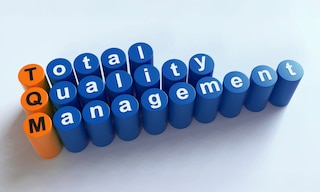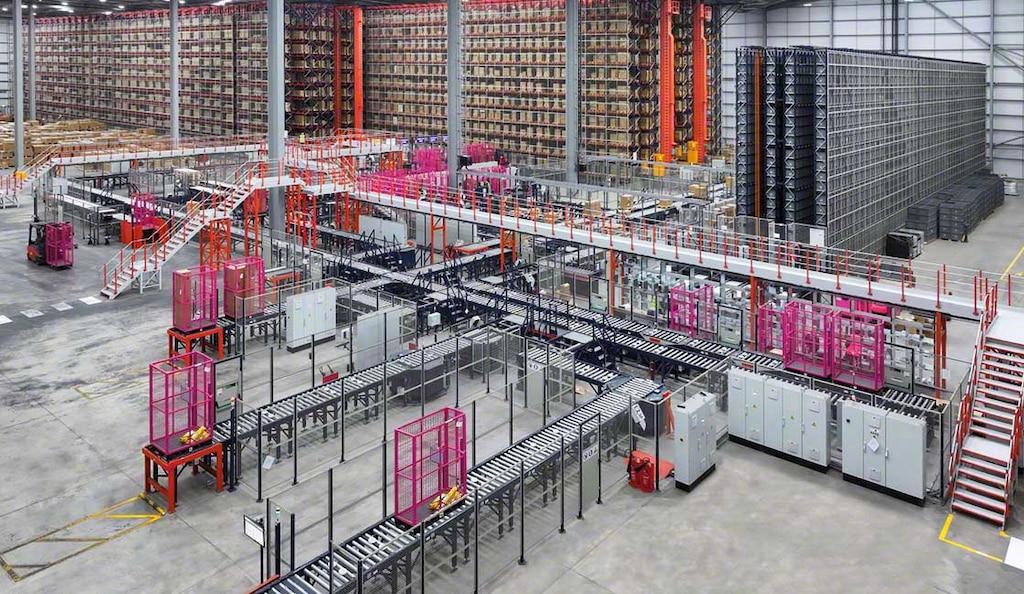
What is total quality management (TQM)?
Total quality management is an effective response to the challenges of an increasingly demanding global market, where customers compare, choose, and buy incredibly quickly. With growing numbers of users and orders, companies look to achieve success by ensuring excellence in their products and services. This requires the entire organization to operate efficiently, flexibly, and with a strong customer focus.
In this post, we explore how total quality management drives improvements in production processes and material flow operations. We’ll also examine how it can be applied in sectors such as logistics.
What is total quality management?
Total quality management (TQM) is a business philosophy centered on continuous improvement. Its goal is to implement strategies and practices that establish the highest standards in products, services, processes, and company culture.
TQM goes beyond perfecting a single product or service: it seeks to enhance the performance of every area within a business. Success depends on engaging all team members by fostering collaboration, proactive problem-solving, and a shared commitment to excellence.
According to the American Society for Quality (ASQ), total quality management can be applied across all industries, supporting individuals, companies, and organizations in improving their processes while maintaining quality and sustainability in a constantly changing market. Meanwhile, the European Foundation for Quality Management (EFQM) emphasizes that TQM is designed to prevent errors, streamline operations, optimize resources, and enhance overall performance. Businesses not only become more efficient; they also strengthen their competitiveness while maintaining consistent long-term results.
The TQM system serves as a comprehensive framework that integrates several philosophies and methodologies geared toward continuous improvement. Notable examples include kaizen, which encourages gradual changes in work practices through the involvement of all employees, and Six Sigma, which uses data analysis to identify and eliminate the root causes of potential issues.
Total quality management principles
Total quality management is built on a set of principles that guide organizations toward continuous improvement and operational efficiency:
- Customer centricity. The primary aim of TQM is to meet consumers’ expectations by thoroughly understanding their needs and delivering the right products and services.
- Employee commitment. All staff, regardless of role or position, should actively participate in the pursuit of continuous improvement. Ongoing training, a culture of responsibility, and engagement are essential.
- Leadership. Managers are responsible for fostering and maintaining a quality-oriented culture. Their involvement should be active and visible, demonstrating commitment to TQM initiatives throughout the organization.
- Supplier relationships. Companies collaborate with suppliers to plan and coordinate operations, from raw material selection to the delivery of inputs.
- Process improvement. TQM relies on continually managing and refining operations to minimize errors and make the best use of resources.
- Informed decision-making. Businesses gather and analyze performance data to understand processes thoroughly and identify potential growth areas.
- Effective communication. Sharing information helps convey a shared vision, encourages employee involvement, reinforces transparency, and facilitates team collaboration.

Benefits of total quality management
Total quality management has become a strategic resource for organizations seeking to stand out in highly competitive environments. Companies that successfully integrate continuous improvement and process reliability practices can position themselves ahead of those still facing adaptability hurdles.
Key advantages of total quality management include:
- Increased productivity through more efficient processes.
- Greater customer satisfaction, resulting in loyalty and positive recommendations.
- Better brand reputation, as customers and partners recognize quality and reliability.
- More effective employee collaboration, fostering communication and teamwork.
- Employee motivation and engagement, by promoting a quality-driven culture and active participation.
- Maximum process control, helping prevent and foresee problems.
- Reduced waste and costs through efficient resource management.
- Adaptability and responsiveness to changing market conditions.
History of total quality management
The modern concept of total quality began to take shape in the early 20th century, when statistical tools were incorporated into manufacturing processes. However, it wasn’t until after World War II that the term total quality management gained real significance.
At that time, American statistician William Edwards Deming (creator of the PDCA or Deming cycle) traveled to Japan to assist in the country’s postwar reconstruction. His teachings on statistical analysis and process management helped Japanese companies overcome deficiencies, paving the way for their later economic success. Over time, Japan would become a global benchmark in quality and efficiency.
The impact of this model sparked international interest, and by the 1980s, many Western organizations had adopted total quality management to respond to growing global competition.
Since then, total quality has evolved into a comprehensive approach applicable across all industries. Today, total quality management is understood as much more than a strategy to upgrade products and processes. It’s become a business philosophy that drives innovation, efficiency, and customer satisfaction in a market where differentiation is vital.
How to implement total quality management
Adopting total quality management goes far beyond process control; it requires a deep cultural shift across a company. Organizations must combine practical initiatives with the philosophy that gives true meaning to TQM.
Practical steps for implementation
The first step toward establishing a total quality management system is having committed leadership. Management must be capable of inspiring and guiding the entire business through the transformation. From there, the company can move forward through several key stages:
- Assess current quality practices. Analyze existing processes, document workflows, and identify both strengths and weak points.
- Set objectives and design a road map. Define clear, measurable benchmarks tied to key performance indicators (KPIs) for customer satisfaction, defect reduction, and operational efficiency.
- Allocate resources. Ensure the quality plan is backed by sufficient funding, the right technology, and qualified personnel to execute it effectively.
- Train staff in TQM. Educate employees on the principles and methods of total quality management, encouraging active participation and shared accountability.
- Promote communication and teamwork. Establish strong internal communication channels that foster transparency, collaboration, and alignment around quality goals.
- Track progress and revise strategies. Use KPIs, metrics, and data analysis to regularly review performance and make informed adjustments along the way.
Deming’s principles as a guide
Deming outlined 14 points that form the core philosophy of total quality management. These guidelines don’t replace the practical steps discussed above — they expand on them, offering a broader vision:
- Establish a clear purpose centered on improving products and services.
- Embrace a new work philosophy, driven by active leadership and commitment to change.
- Replace constant inspection with quality integrated into processes from the start.
- Build long-term, trust-based relationships with suppliers.
- Continuously fine-tune planning and production processes.
- Provide training at every level of the business.
- Lead in a way that enables individuals and teams to perform at their best.
- Eliminate fear of making mistakes and punishment to create a productive, open work environment.
- Break down silos and encourage cross-functional collaboration.
- Avoid slogans that call for “zero defects” without setting out concrete methods to attain that goal.
- Pursue sustainable improvement rather than zeroing in solely on numbers.
- Remove obstacles — such as inefficient processes or lack of recognition — that prevent employees from taking pride in their work.
- Promote ongoing education and personal development.
- Engage the entire organization in the transformation toward quality, inspiring everyone to take ownership of the process.

TQM in logistics and practical applications
Total quality management in logistics is reflected in well-structured planning that enables agile, reliable service for customers. Companies must anticipate consumer needs and deliver effective solutions. This calls for on-time deliveries, incident-free transportation and storage, and close collaboration with trusted suppliers. The objective is to guarantee consistency and continuous improvement throughout the supply chain.
Nowadays, it’s virtually impossible to incorporate TQM into logistics operations effectively without a warehouse management system. This software integrates processes and minimizes errors, allowing businesses to implement targeted upgrades across key areas:
- Storage. Strategic product organization speeds up order processing, inventory control, and replenishment while reducing errors and downtime.
- Stock management. A warehouse management system (WMS) provides real-time inventory control, data analysis, and demand forecasting to enhance decision-making.
- Returns. An efficient returns management protocol streamlines product exchanges, refunds, and clear communication with customers.
- Traceability. Digitalization enables product traceability, the ability to track every movement goods make throughout the supply chain.
- Automation. Technologies such as AMRs, stacker cranes, and pallet conveyor systems optimize operations and help meet higher, more consistent quality standards.
Total quality management to drive competitiveness
Total quality management combines a set of tools and practices aimed at achieving the highest level of excellence. More than a methodology, it’s a comprehensive work philosophy that reshapes how companies understand their processes and relationships. At its core lies the collaboration of all stakeholders — customers, employees, and suppliers — to build a cohesive, flexible system centered on continuous improvement.
In logistics, where speed, accuracy, and reliability are critical, TQM provides an effective response to the demands of an increasingly competitive, globalized market. This model goes beyond simply delivering products on time; it seeks to create value at every stage of the supply chain, from planning and procurement to storage, transportation, and after-sales service.
Total quality management in 5 questions
What is total quality management?
Total quality management (TQM) is a business management philosophy focused on continuous improvement. The goal is to optimize products, processes, and services through the active participation of all members of a company, fostering customer satisfaction, operational efficiency, innovation, and collaboration with suppliers.
What are the benefits of TQM?
Total quality management offers numerous advantages. It boosts customer satisfaction and loyalty, increases productivity, leverages resources wisely, lowers costs, strengthens competitiveness, and encourages innovation. Additionally, it promotes supplier collaboration and streamlines processes, aligning operations with continuous improvement.
What are the principles of total quality management?
TQM relies on these principles designed to achieve organizational excellence: prioritizing the customer, engaging all employees, active leadership, trust-based supplier relationships, continuous process improvement, data-driven decision-making, and effective communication. These pillars help integrate quality and efficiency across every business area.
How do you implement total quality management?
Adopting TQM requires a cultural shift driven by committed leadership. It involves evaluating processes, setting clear objectives, allocating adequate resources, and training staff. It also calls for fostering communication, collaboration, and teamwork, as well as monitoring results through KPIs to ensure continuous improvement and strategic alignment.
What’s the origin of total quality management?
TQM emerged in the early 20th century with the use of statistical tools to enhance production. After World War II, W. Edwards Deming introduced process management and quality control in Japan. This laid the foundation for an integrated approach to continuous improvement that later gained global recognition.
